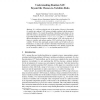197 search results - page 30 / 40 » Learning correlations using the mixture-of-subsets model |
HPCA
2008
IEEE
14 years 8 months ago
2008
IEEE
Recent advances in statistical inference and machine learning close the divide between simulation and classical optimization, thereby enabling more rigorous and robust microarchit...
KDD
2004
ACM
14 years 8 months ago
2004
ACM
Transformation of both the response variable and the predictors is commonly used in fitting regression models. However, these transformation methods do not always provide the maxi...
CVPR
2009
IEEE
15 years 2 months ago
2009
IEEE
The articulated body models used to represent human motion typically have many degrees of freedom, usually expressed as joint angles that are highly correlated. T...
CP
2004
Springer
14 years 1 months ago
2004
Springer
It is well known that the ratio of the number of clauses to the number of variables in a random k-SAT instance is highly correlated with the instance’s empirical hardness. We con...
MVA
2007
13 years 9 months ago
2007
We present an approach for simultaneous monocular 3D face pose and facial animation tracking. The pose and facial features are estimated from observed raw brightness shape-free 2D...

